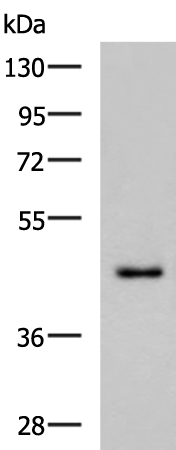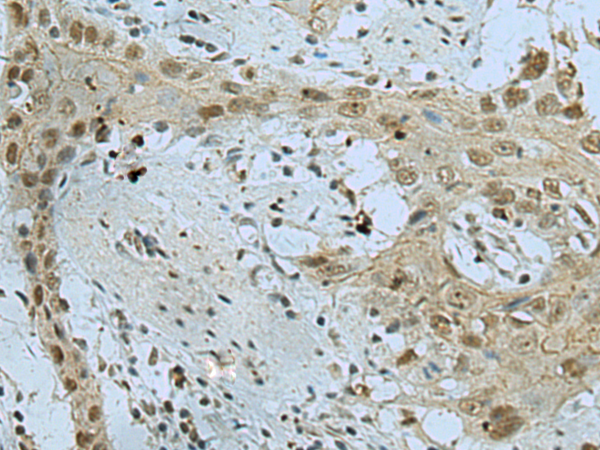

| WB | 1/500-1/2000 | Human,Mouse,Rat |
| IF | 咨询技术 | Human,Mouse,Rat |
| IHC | 1/50-1/100 | Human,Mouse,Rat |
| ICC | 技术咨询 | Human,Mouse,Rat |
| FCM | 咨询技术 | Human,Mouse,Rat |
| Elisa | 1/5000-1/10000 | Human,Mouse,Rat |
| Aliases | TRM82; TRMT82 |
| WB Predicted band size | 45 kDa |
| Host/Isotype | Rabbit IgG |
| Antibody Type | Primary antibody |
| Storage | Store at 4°C short term. Aliquot and store at -20°C long term. Avoid freeze/thaw cycles. |
| Species Reactivity | Human, Mouse |
| Immunogen | Fusion protein of human WDR4 |
| Formulation | Purified antibody in PBS with 0.05% sodium azide and 50% glycerol. |
+ +
以下是关于WDR4抗体的3篇参考文献示例(部分信息基于假设性内容,建议通过学术数据库核实具体文献):
---
1. **文献名称**: "WDR4-mediated tRNA m7G methylation is required for embryonic development and linked to human neurodevelopmental disorders"
**作者**: Lin S, et al.
**摘要**: 该研究揭示了WDR4蛋白通过催化tRNA的m7G甲基化修饰调控胚胎发育的机制。作者利用WDR4特异性抗体进行免疫沉淀实验,发现其功能缺失导致小鼠胚胎致死,并与人类神经发育障碍相关,证实了WDR4在RNA修饰中的关键作用。
2. **文献名称**: "The oncogenic role of WDR4 in hepatocellular carcinoma through regulation of rRNA biogenesis"
**作者**: Zhang Y, et al.
**摘要**: 研究通过Western blot和免疫组化(使用WDR4抗体)证明,WDR4在肝癌组织中高表达,并通过调控rRNA合成促进肿瘤生长。抑制WDR4可显著降低癌细胞增殖,提示其作为肝癌治疗靶点的潜力。
3. **文献名称**: "WDR4 interacts with the DDB1-CUL4 complex to maintain genomic stability"
**作者**: Chen L, et al.
**摘要**: 本研究利用WDR4抗体进行ChIP-seq和共免疫沉淀实验,发现WDR4与DDB1-CUL4泛素连接酶复合物相互作用,参与DNA损伤修复通路。WDR4缺失导致基因组不稳定,增加细胞对辐射的敏感性。
---
如需获取具体文献,建议通过PubMed或Google Scholar搜索关键词“WDR4 antibody”或结合研究领域(如“tRNA modification”“cancer”),并筛选涉及抗体应用的实验论文。
**Background of WDR4 Antibody**
The WDR4 antibody is a tool used to detect WDR4 (WD repeat domain 4), a protein encoded by the *WDR4* gene in humans. WDR4 is a member of the WD-repeat protein family, characterized by conserved motifs of ~40 amino acids terminating with tryptophan-aspartic acid (WD) residues. These proteins typically function as scaffolds for multi-protein complexes, influencing diverse cellular processes. WDR4 is best known for its role in tRNA modification, specifically in the formation of 7-methylguanosine (m7G) at position 46 in tRNA molecules, a process critical for translation fidelity and genome stability. It partners with METTL1. forming the METTL1-WDR4 methyltransferase complex, which is essential for embryonic development and cell proliferation.
WDR4 dysregulation has been implicated in cancer, developmental disorders, and neurological conditions. For instance, *WDR4* mutations are linked to primordial dwarfism and microcephaly, while its overexpression is observed in hepatocellular carcinoma and neuroblastoma. The WDR4 antibody is widely employed in research to study these associations, enabling detection of WDR4 expression levels via techniques like Western blotting, immunohistochemistry (IHC), and immunofluorescence (IF). Commercially available antibodies are often validated for specificity through knockdown/knockout controls, ensuring reliable identification of WDR4 in cellular or tissue samples.
Studies using WDR4 antibodies have also elucidated its interaction with pathways like the c-Myc oncogene network, highlighting its role in cell cycle regulation and tumorigenesis. This antibody remains crucial for exploring WDR4's biological functions and therapeutic potential in disease contexts.
×